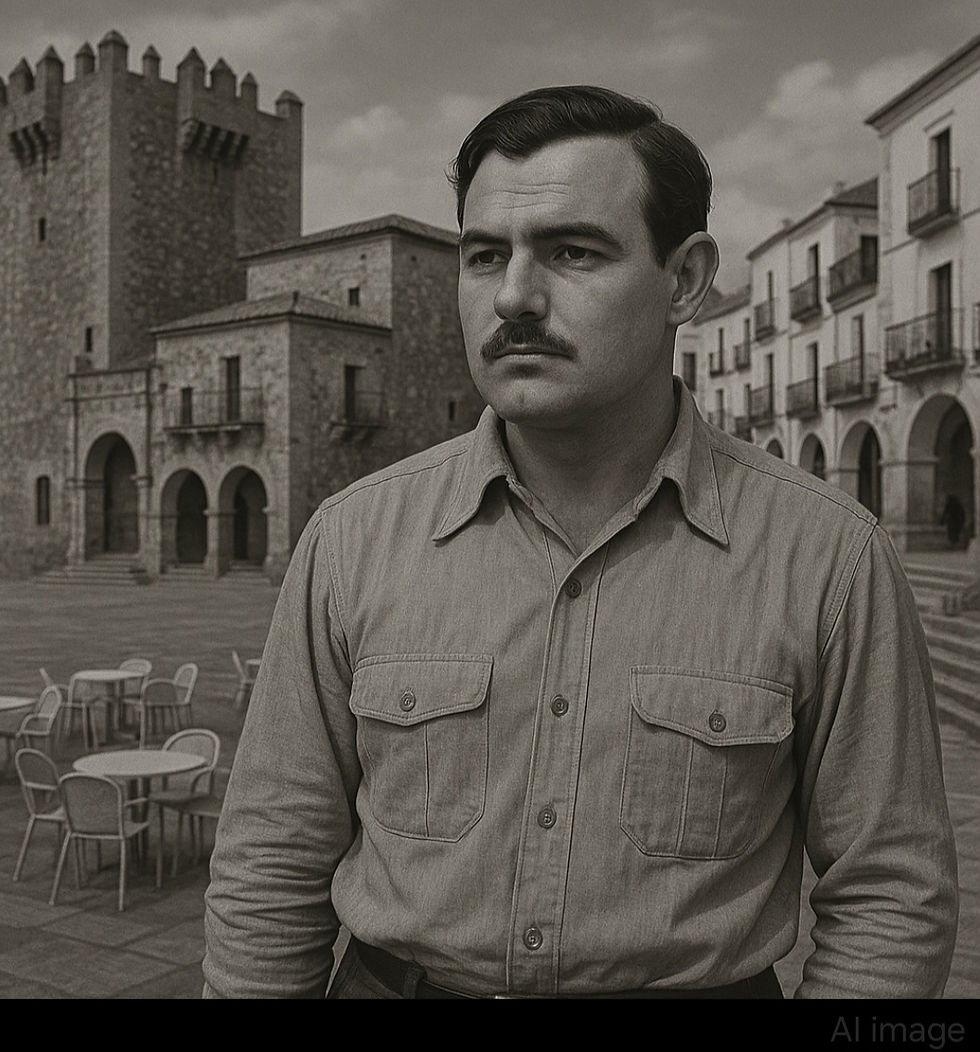Hemingway on Extremadura...and Extremadura’s Last Bear
- Mark Eveleigh
- Aug 11
- 4 min read
Updated: Aug 12
Several generations of readers have been lured to Spain by the words of Ernest Hemingway. I was drawn first to Pamplona by his immortal The Sun Also Rises in the early 1990s and returned each year. At the start of each fiesta my friends and I would take our wine-skins along to the oversized statue of Hemingway outside the Pamplona bullring. We’d toast the great writer while we tied an extra pañuelo (the red ‘bandanna’ that’s an obligatory feature of Las Fiestas de San Fermín) around his granite neck.

I settled for a decade in Pamplona and also lived for six years in Madrid, following his footsteps there too…often it seemed at almost every turn. A restaurant near my house famously had a huge sign out front stating that ‘Hemingway Never Ate Here’.

He hunted through much of the country and fished famously in almost every Basque and Navarran valley, from Apezborro to Xantelerreka. If even half the stories are true Hemingway travelled through almost the entire country. For a man who tramped so tirelessly it seems amazing that, as far as we know, he never set foot in Extremadura!
Hemingway nevertheless wrote about the province in Islands in the Stream (published in 1970, nine years after the writer’s death): ‘There are whole villages in Extremadura in Spain that are built of rock that has very high grade wolfram ore and the stone fences of the peasant’s field are all made of this ore. Yet the peasants are very poor. At this time it was so valuable that we were using DC-2’s, transport planes such as fly to Miami, to fly it over from a field at Nam Yung in Free China to Kai Tak airport at Kowloon. From there it was shipped to the States. It was considered very scarce and of vital importance in our preparations for war…’

Extremadura featured too in a conversation – supposedly during a lull in shelling during the Spanish Civil War – that he described in a short story called Under the Ridge:
“I am an Extremaduran and I hate foreigners,” says one of the Spanish soldiers. “In Badajoz, we have been sacked and pillaged and our women violated by the English, the French and now the Moors. What the Moors have done now is no worse than what the English did under Wellington. You should read history. My great-grandmother was killed by the English. The house where my family lived was burned by the English…”
“You understand my hatred?” asked the Extremaduran.
“I understand your hatred,” I said.
“Good,” he said and put out his hand. “I do not refuse to shake hands. And that you, personally, have much luck.”
In the summer of 1931 ‘Don Ernesto’ came within less than 14km of Extremadura when he visited Navacepeda de Tormes (Castilla y León). The village – population still only around 200 people – is certainly unique for the fact that its church has a bear paw nailed on the door. You can still see it today on the heavy timber door of the 400 year old La Iglesia de San Juan Bautista. Hemingway saw that paw and, nine years later, attributed it to one of the characters in For Whom the Bell Tolls: ‘On the door of the church of my village was nailed the paw of a bear that I killed in the spring,’ says the militia leader Anselmo.

It’s just the sort of story that would have appealed to the fanatical hunter. Unfortunately, that bear might well have been the last to survive in the Sierra de Gredos. Apart from that claw, all that remains as evidence of their passing today are ancient stone carvings of bears left by the Celtic tribes who also hunted through the sierras.
The main plaza in Navacepeda de Tormes is known as Plaza del Embarcadero, but it was most likely named lightheartedly as a departure point for mule-trains rather than – in this landlocked region – for any actual barcos (boats). From this plaza Hemingway’s eyes would surely have been drawn to the nearby peaks that, rising to 2,591m and snow-capped for much of the year, form the boundary with Extremadura.

Could he really have been so close and yet have resisted the temptation to visit that great and thrilling land of rock just a stone’s throw away? It’s likely that the idyllic trout fishing pools near Plasencia's Río Jerte and Garganta de Jaranda (in Sierra de Gredos' southern flanks) were still a closely guarded secret. Even Hemingway may well have been intimidated by the fearfully named Garganta de los Infiernos (‘Throat of Hell’), yet this 16-km hiking trail through what is now a nature reserve just three hours drive from Madrid, is often rated as one of the Spain’s best hiking trails. Hunting is still popular in Extremadura, of course, but perhaps Hemingway would have been happy with merely watching wildlife in natural habitats like Arribes del Duero, Campiña Sur or Matachel (east of Zafra) which is home to most of Extremadura’s 200 or so Iberian lynxes.


